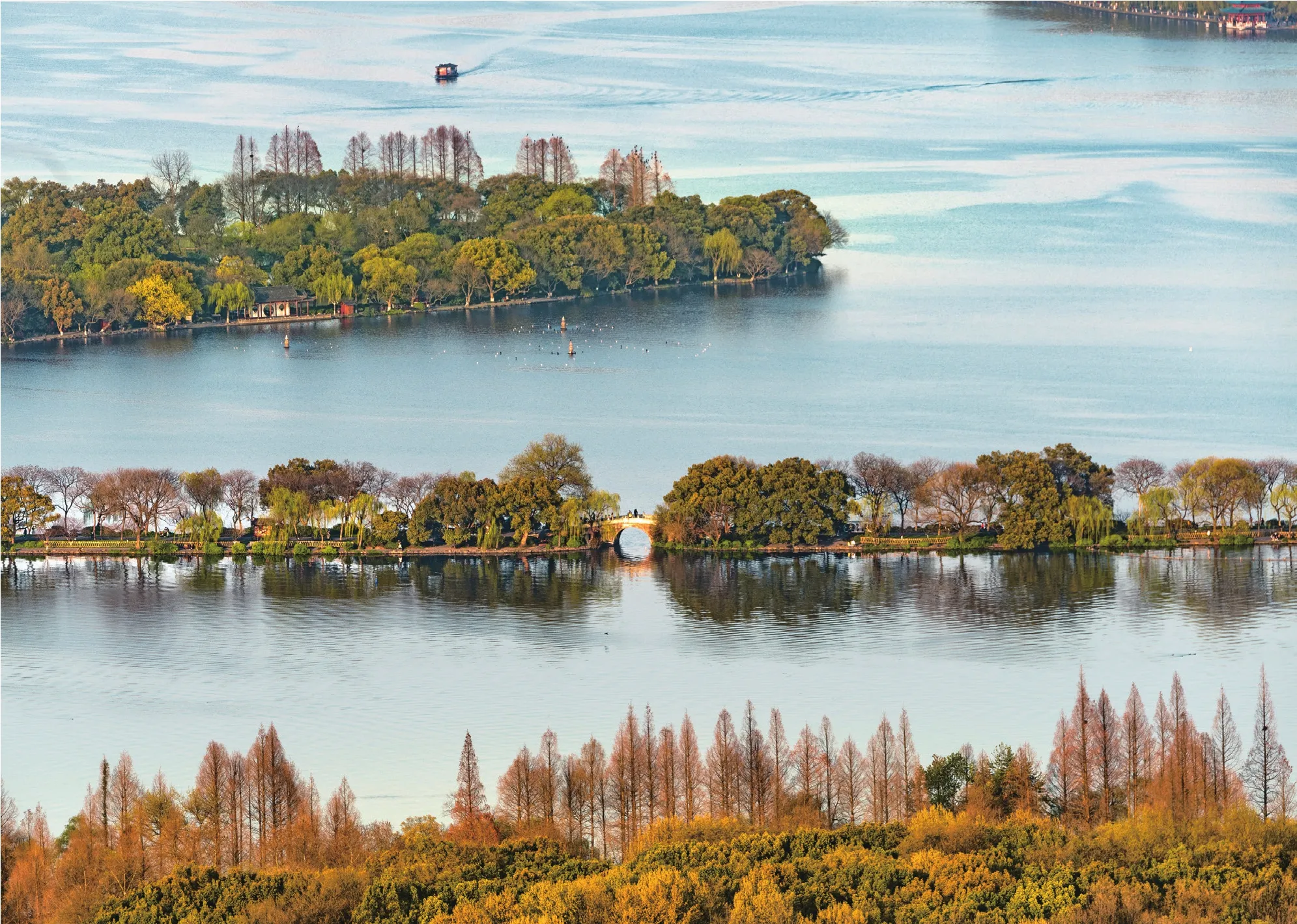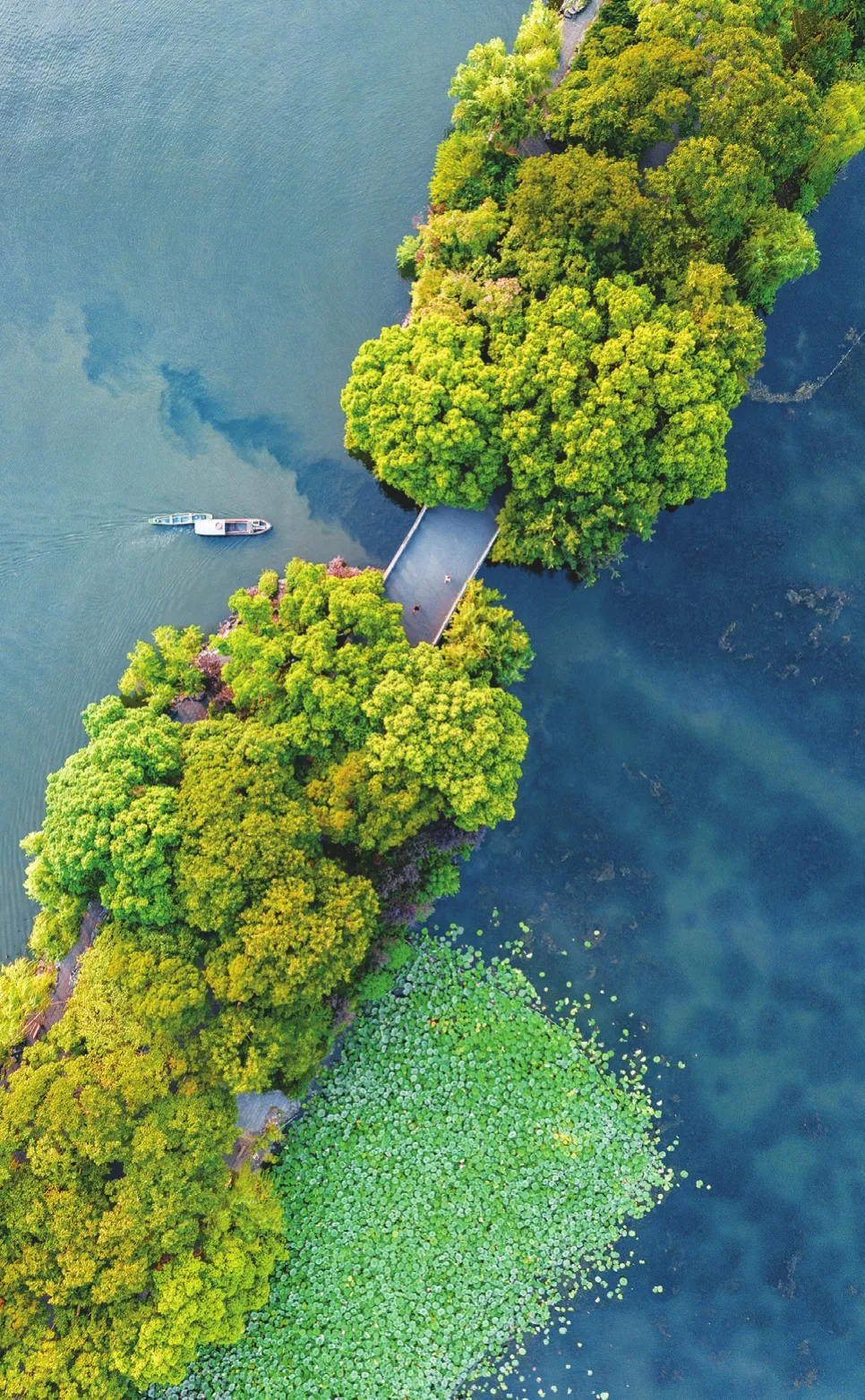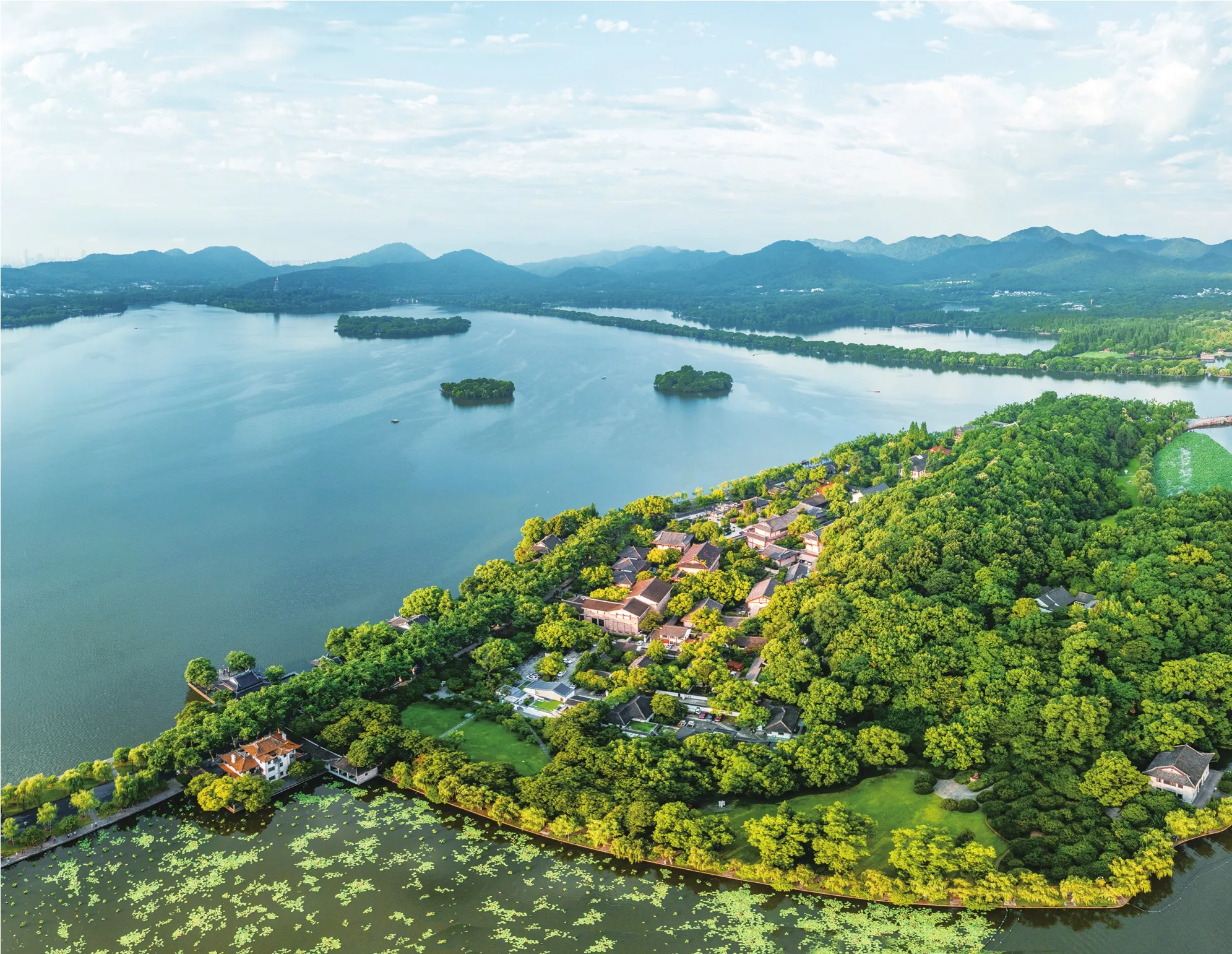苏堤名探源
2022-10-28司马一民
文/ 司马一民

西湖苏堤锁澜桥。肖奕叁/摄The Suolan Bridge along the Su Causeway on the West Lake. Photo by Xiao Yisan.
楼外楼头雨似酥,淡妆西子比西湖。
江山也要文人捧,堤柳而今尚姓苏。
这是民国二十四年(1935)夏,中国现代著名作家郁达夫在杭州西湖楼外楼写下的诗《乙亥夏日楼外楼坐雨》。
民国二十二年(1933)四月,郁达夫由上海移居杭州,在杭州写下了不少山水游记和诗词。遥想当年,郁达夫饮酒于楼外楼,恰逢细雨蒙蒙,眺望苏堤,翠色蜿蜒,正所谓“晴西湖不如雨西湖”,兴之所至,郁达夫吟出了这首诗。
这首诗突出了苏东坡的文人地位,把杭州,特别是西湖景观与文人的关系定位成以文人为主导,这多少反映了作者作为文人的自负。其实苏东坡在修筑苏堤时,倒真的只是从官员的身份出发考虑如何改善民生。
元祐五年(1090)四月二十九日,苏东坡在杭州知州任上写了一篇《乞开杭州西湖状》上奏朝廷,列出了疏浚西湖的五条理由,得到了朝廷的同意。
苏东坡有诗《轼在颍州与赵德麟同治西湖,未成,改扬州。三月十六日湖成,德麟有诗见怀,次其韵》纪事。此诗作于元祐七年(1092)扬州知州任上。元祐六年(1091)苏东坡从杭州调任颍州知州,与赵令畤(原先字景贶,后来苏东坡为他改字德麟,宋太祖次子燕王德昭玄孙,苏东坡任颍州知州时,赵令畤为通判,二人为好友)一起疏浚颍州西湖。第二年,即元祐七年(1092),疏浚颍州西湖工程还没有完工,苏轼又调任扬州知州,后来赵令畤寄来诗笺,告诉苏东坡,疏浚颍州西湖的工程已经完成,苏东坡便写了此诗作答。在诗中,苏东坡回忆疏浚杭州西湖的过程,湖中挖出的淤泥筑成了长堤,上植杨柳,又架筑了六桥,使杭州西湖面目一新。
此诗大意为:泰山高大,但不是最大的;秋毫细微,但不是最小的。事物的大和小只存在于相互比较之中。大千世界里,生成和毁灭总是从微小开始的,杭州与颍州的两个西湖没有优劣之分。我在钱塘时疏浚西湖,使湖水清澈,男男女女在十里长堤上游乐。横跨湖面的六桥看上去如同跨越在天上的银河上,北山和南屏山因为有了长堤才开始相连。当初人们惊讶二十五万丈宽的葑田,如乌云密布般,如何处置呢?现在都被用来筑堤,这样的废物利用,变成了西湖的一道景色。前些天我在颍州西湖欣赏秋色,湖水犹如一条绿色的锦带环绕着昭灵宫。此情此景,让我想起了杭州的西湖,可惜我不可能再去杭州看看西湖了。现在借你的手疏浚颍州西湖,使得湖水清澈,即使要我用扬州二十四桥来换颍州西湖的绿水清风,我觉得也是值得的。雷塘水已干涸并长满了禾黍,种田人在淤泥中挖出了前朝宫人的金钗。如果明年你来扬州凭吊,我会和秋虫一起在凉夜里陪伴你。
那么,何时有了苏堤的名称呢?
据吴自牧(南宋末年钱塘人,生平事迹不详)所著的《梦粱录》卷十二记载:“曰苏公堤。元祐年东坡守杭,奏开浚湖水,所积葑草,筑为长堤,故命此名,以表其德云耳。自西迤北,横截湖面,绵亘数里;夹道杂植花柳,置六桥,建九亭,以为游人玩赏驻足之地。咸淳间,朝家给钱,命守臣增筑堤路,沿堤亭榭再一新,补植花木。向东坡尝赋诗云:‘六桥横绝天汉上,北山始与南屏通。忽惊二十五万丈,老葑席卷苍烟空。’”
可见,苏堤的名称应当始于南宋。
在南宋时,朝廷出资在堤上筑路,还对堤上的亭榭进行了修葺,并且在堤上广种花木,真正形成了苏堤景观。
南宋时把西湖及其周边的十处特色风景称为“西湖十景”,分别为:苏堤春晓、断桥残雪、曲院风荷、花港观鱼、柳浪闻莺、雷峰夕照、三潭印月、平湖秋月、双峰插云、南屏晚钟。至于“西湖十景”具体形成于哪一年,无考。
南宋时,苏堤春晓被列为西湖十景之首,元代又称之为六桥烟柳,将其列入“钱塘十景”。苏堤春晓是指寒冬过后,苏堤花柳争发,有报春的意思在里面。
苏堤由南向北有映波桥、锁澜桥、望山桥、压堤桥、东浦桥和跨虹桥,杭州人将这六座桥俗称为“六吊桥”,现在苏堤望山桥南面的御碑亭里立有康熙所题的“苏堤春晓”碑刻。
(1)日照温度荷载、骤然温降温度荷载与年温变化温度荷载均会在桥梁形成附加效应,即温度荷载效应。因年温变化相对简单,且基本呈均匀分布状态,同时工程设计阶段经常对这一因素予以考虑,所以本次只对日照温度荷载与骤然温降温度荷载进行研究。
历来咏苏堤的诗词有许多,南宋葛天民(生卒年不详),字无怀,山阴(今浙江绍兴)人,居杭州西湖,著有《无怀小集》,写有《正月二十七雨中过苏堤》:
一堤杨柳占春风,柳外群山细雨中。
人苦未晴浑不到,只宜老眼看空濛。
此诗点出了苏堤报春的特点,还借用苏轼“山色空蒙雨亦奇”的意境来描绘苏堤的景色。按葛天民生活的年代推断,苏东坡疏浚西湖并筑堤后大约七十年,就有了“苏堤”的名称了。

俯瞰苏堤映波桥。肖奕叁/摄The Yingbo Bridge along the Su Causeway on the West Lake seen from above.Photo by Xiao Yisan.
The Origins of the Name “Su Causeway”
By Sima Yimin
“Rivers and mountains do need a literary hand, and the willows on the causeway are still surnamed Su,” thus wrote Yu Dafu (1896-1945), one of China’s most celebrated contemporary writers, in a poem as he visited the West Lake in Hangzhou city,sitting in the famous Lou Wai Lou Restaurant in the summer of 1935.
In April 1933, he moved from Shanghai to the city, where he composed quite a few travel essays and poems. At the time when he penned the above lines, the rain drizzled outside Lou Wai Lou,where Yu was enjoying his wine. Overlooking the winding Su Causeway, which was surrounded by green willows, he couldn’t help but utter his innermost feelings about the scenery. After all,“the West Lake on clear days is no match for the West Lake on rainy days”.

绿意葱茏的苏堤。肖奕叁/摄The Su Causeway covered in greenery. Photo by Xiao Yisan.
More important perhaps is Yu’s highlighting the role of Su Shi(aka Su Dongpo, 1037-1101) in shaping the landscape of the West Lake as a literary figure. In fact, when Su decided to build the Su Causeway, he only intended to improve the livelihoods of the local people as a Hangzhou official.
In 1089, Su came to the city for a second time to serve as its prefect. A few months later, in 1090, he submitted a memorial to the Song (960-1279) emperor, seeking the approval to dredge the West Lake.
In the memorial Su presented five reasons for doing so,including securing the supply of drinking water for residents,helping irrigate farmlands and fostering the development of official brewing industry (an important source of tax revenue for the court), among others. The emperor granted his approval. During the dredging process, a causeway was gradually built with the recycled mud, on which willows were planted and six bridges were constructed.
In 1091, Su was appointed as the prefect of Yingzhou(present-day Fuyang, Anhui province). There, he started another dredging project: incidentally, the lake in Yingzhou was also called the West Lake. However, before Su could finish his job, he was transferred yet again the next year, to serve as the prefect of Yangzhou this time. While there, he received a letter from Zhao Lingzhi (1051-1134), who had been Su’s deputy in Yingzhou,informing him that the dredging project had been completed. In his reply to Zhao, Su couldn’t help but reminisce about the “old days” when he toiled around the West Lake in Hangzhou and helped build the Su Causeway.
To show appreciation for and commemorate the achievements of Su Dongpo in his management of the West Lake, local people later named the long causeway running from north to south in the West Lake of Hangzhou the “Su” Causeway.
But when did the name actually come up and start to catch on?
It is generally believed that the name emerged during the Southern Song dynasty (1127-1279). For example, in Mengliang Lu, or Dreaming Over a Bowl of Millet, the author Wu Zimu,who lived roughly in the late years of the Southern Song period,explained that the “… the Su Causeway… was built with the mud dredged from the West Lake when Su Dongpo served as Hangzhou’s prefect during the Yuanyou era [1086-1094]. Hence the name of the causeway… running for several kilometers,flowers and willows are planted on the two sides of the causeway.Six bridges and nine pavilions were then set up for visitors to enjoy the scenery. During the Xianchun era [1265-1274], the imperial court paid to pave the road on the causeway, renovate the pavilions and planted new flowers and trees…”
It was during the Southern Song dynasty that scenery around the Su Causeway had taken its shape as is known today. Indeed, it was also at the time that the epithet “Top 10 Sceneries of the West Lake” began to gain currency.

晨光中的苏堤压堤桥。肖奕叁/摄The Yadi Bridge along the Su Causeway in the morning. Photo by Xiao Yisan.
